
The Prague Astronomical Clock or Prague Orloj is a medieval astronomical clock attached to the Old Town Hall in Prague, the capital of the Czech Republic.
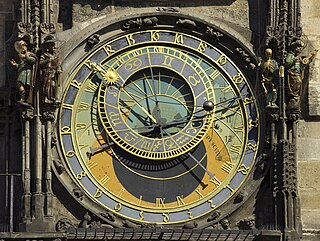
An astronomical clock, horologium, or orloj is a clock with special mechanisms and dials to display astronomical information, such as the relative positions of the Sun, Moon, zodiacal constellations, and sometimes major planets.

Bourges Cathedral is a Roman Catholic church located in Bourges, France. The cathedral is dedicated to Saint Stephen and is the seat of the Archbishop of Bourges. Built atop an earlier Romanesque church from 1195 until 1230, it is largely in the High Gothic architectural style and was constructed at about the same time as Chartres Cathedral. The cathedral is particularly known for the great size and unity of its interior, the sculptural decoration of its portals, and the large collection of 13th century stained glass windows. Owing to its quintessential Gothic architecture, the cathedral was declared a UNESCO World Heritage Site in 1992.
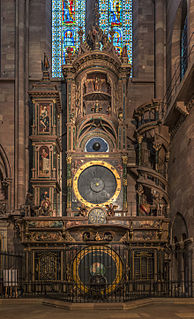
The Strasbourg astronomical clock is located in the Cathédrale Notre-Dame of Strasbourg, Alsace, France. It is the third clock on that spot and dates from the time of the first French possession of the city (1681–1870). The first clock had been built in the 14th century, the second in the 16th century, when Strasbourg was a Free imperial city of the Holy Roman Empire.

Jean-Baptiste Schwilgué was the author of the third astronomical clock of Strasbourg Cathedral, built between 1838 and 1843 . In 1844 Schwilgué, together with his son Charles, patented a key-driven calculating machine, which seems to be the third key-driven machine in the world, after that of Luigi Torchi (1834) and James White (1822).

Isaac (1544–1620) and Josias (1552–1575) Habrecht were two clockmaker brothers from Schaffhausen, Switzerland.

St Mark's Clock is housed in the Clock Tower on the Piazza San Marco in Venice, Italy, adjoining the Procuratie Vecchie. The first clock housed in the tower was built and installed by Gian Paolo and Gian Carlo Rainieri, father and son, between 1496 and 1499, and was one of a number of large public astronomical clocks erected throughout Europe during the 14th and 15th centuries. The clock has had an eventful horological history, and been the subject of many restorations, some controversial.
Klinghammer's computus is a mechanism determining the elements of the computus, in particular the date of Easter in the Gregorian calendar. This mechanism was built in the 1970s by Frédéric Klinghammer (1908–2006) and is nearly a reduced model of the computus found on the Strasbourg cathedral astronomical clock.
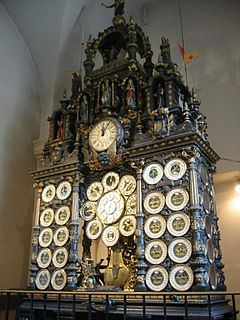
The Besançon astronomical clock is housed in Besançon Cathedral. Auguste-Lucien Vérité fr:Auguste-Lucien Vérité of Beauvais designed and built Besançon's present astronomical clock, between 1858 and 1863. It replaced an earlier clock that Bernardin had constructed in the 1850s that proved unsatisfactory. Besançon's clock differs from those in Strasbourg, Lyon, and Beauvais. The clock is meant to express the theological concept that each second of the day the Resurrection of Christ transforms the existence of man and of the world.

The Kremlin Clock or Kremlin Chimes, also known colloquially in the West as Moscow Clock Tower, is a historic clock on the Spasskaya Tower of Moscow Kremlin. The clock dial is above the main gates to Red Square. For decades, the chimes have rung on the quarter-hour, with bells tolling for each full hour.

The Exeter Cathedral Astronomical Clock is a fifteenth-century astronomical clock in Exeter Cathedral, England. It displays the hour of the day, the day of the lunar month and the phase of the moon. The modern clock mechanism was installed in 1885 by Gillett & Bland of Croydon, and restored in 1910.
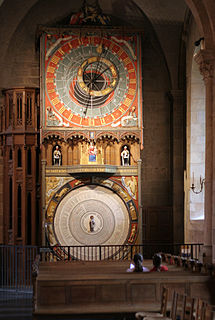
Lund astronomical clock, occasionally and at least since the 16th century referred to as Horologium mirabile Lundense, is a 15th-century astronomical clock in Lund Cathedral. Mentioned in written sources for the first time in 1442, it was probably made and installed sometime around 1423–25, possibly by Nikolaus Lilienfeld. It is part of a group of related medieval astronomical clocks found in the area around the south Baltic Sea. In 1837 the clock was dismantled. Between 1909 and 1923, it was restored by the Danish clockmaker Julius Bertram-Larsen and the Swedish architect responsible for the upkeep of the cathedral, Theodor Wåhlin. From the old clock, the face of the clock as well as the mechanism, which was largely replaced during the 18th century, was salvaged and re-used. The casing, most parts of the calendar which occupies the lower part, and the middle section were made anew.
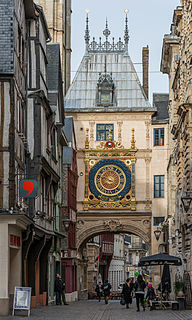
The Gros-Horloge is a 14th century astronomical clock in Rouen, Normandy.
The Lyon astronomical clock is a seventeenth-century astronomical clock in Lyon Cathedral.

The astronomical clock of Messina is an astronomical clock constructed by the Ungerer Company of Strasbourg in 1933. It is built into the campanile of Messina Cathedral.

The Torre dell'Orologio is a 15th-century renaissance tower on the Piazza delle Erbe in Mantua, Italy. It is attached to the Palazzo della Ragione, and next to the Rotonda di San Lorenzo. It houses an astronomical clock.

The Zytturm is a 13th-century tower in Zug, Switzerland, which houses an astronomical clock. The tower, which is 52 metres high, is located on Kolinplatz in the old town centre.

A computus clock is a clock equipped with a mechanism that automatically calculates and displays, or helps determine, the date of Easter. A computus watch carries out the same function.
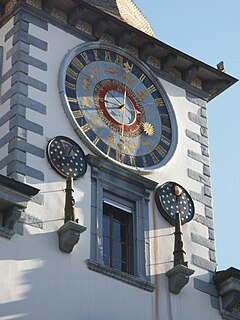
The Sion astronomical clock is an astronomical clock at the town hall of Sion in the canton of Valais, Switzerland. The clock was first installed in 1667–68; the present mechanism dates from 1902.

The Münster astronomical clock is an astronomical clock in Münster Cathedral in Münster, Germany.



















